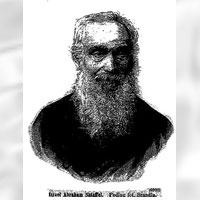
Izrael Abraham Staffel was born in 1814 and died in 1885 in Warsaw, Poland. In 1833, when he was only 19, opened a clockmaker shop, where he worked, in two different locations, till the end of his life. He spent most of his life on developing various inventions, primarily the calculating machines, for which he obtained multiple prizes, but he also invented other devices, such as an anemometer, a fan, a probe for determining the contents of alloys, a counterfitting machine, and a press for printing stamps. Unfortunately, he did not seem to patent any of his inventions and died extremely poor and sick.
Major Contribution: Invention of an arithmetic machine for four operations and a square root (1844) [1-4].
Basic Questions
How was the machine built and how it operated? Staffel presented his machine for the first time, after ten years of work, at the industrial exhibit in Warsaw, in 1845. However, its description has been published in English in the Report of the Juries [2] of the Great Exhibit in London, in 1851, where Staffel got a gold medal. The report, describing the calculating machines presented at the Exhibit, says the following about Staffel’s machine: “The best machine of this kind exhibited is that of Staffel (Russia, 148), which, on examination, seems to combine accuracy with economy of time, and works easily and directlyâ€. It was evaluated higher than the machine presented by Thomas de Colmar, which was a real sensation. The Illustrated London News also published an enthusiastic article, with the description of the machine and its picture [3]: “In the Russian Court, modestly secluded amidst the glitter of malachite doors and vases, jewellery and silver, there is one work, the produce of high intelligence, and intended to assist in certain intellectual labours. This solitary tribute of mind to minds comes not from Petersburg, nor Mexico [meant Moscow], nor from Siberia, nor from the Ural Mountains, but from Poland. We refer to Staffel’s Calculating Machine, No. 148 in the Catalogueâ€. A copy of the Staffel’s machine exists in the Museum of Technology in Warsaw [4].
Significance
Even before the publicity due to the prize at the Great Exhibit in London, Steffel’s machine was very positively assessed by the Russian Academy of Sciences in St. Petersburg, in 1846 [5]. Two famous mathematicians, V. Buniakovskii and B. Jacobi, gave it a very positive opinion and Staffel was awarded a very prestigious Demidov prize. Further, after the London Exhibit, a brief note in Scientific American appeared saying [6]: “An extraordinary calculating machine, says the London Times, is now placed in the Russian Court. It is the invention of a Polish Jew, named Staffel, a native of Warsaw, and works addition, subtraction, multiplication and division, with a rapidity and precision that are quite astonishing.†Even many years later, in the Reports of the United States Commissioners to the Paris Universal Exposition, 1867, Staffel’s machine is praised in Chapter XVIII “Metrology and Mechanical Calculationâ€: “Of the numerous calculating machines which have been proposed or constructed since that of Mr. Thomas became an ascertained success, those of Messrs. Maurel & Jayet of France, and of Mr. Staffel of Russia, are the only ones which, so far as is known, have solved the problem in a manner entirely satisfactory.†Once source [7] says that Staffel was accepted as a corresponding member to the Paris Society of Industrial Arts, but that could not be independently confirmed.
Findings
The historical contribution of this website is in putting together multiple pieces of information on Izrael Staffel, previously available from different sources and in multiple languages [7-10]. One historically important issue is worth mentioning, since it has never been raised by experts [1]. This is the fact that the Report of the Juries [2], in the last paragraph of the description of Staffel’s machine, mentions another machine “for the performance of the addition and subtraction of fractionsâ€. It looks like a new machine by Staffel, never mentioned in any other publication.
References [hide]
[1] E. Wyka, Mechanik warszawski Abraham Izrael Staffel (1814-1885) i jego wynalazki (in Polish: A Warsaw Mechanic Abraham Izrael Staffel 1814-1885 and His Inventions), unpublished, linked to this website; English translation is in progress
[2] Calculating Machines, Reports by the Juries on the Subjects in the Thirty Classes unto which the Exhibition Was Divided. Great Exhibition, London, 1851, Class X, p. 310
[3] Staffel’s Calculating Machine, The Illustrated London News, Exhibition Supplement, Vol. 19, No. 518, September 30, 1851
[4] Arithmometer by Izrael Abraham Staffel, Museum of Technology, Palace of Culture and Science, Warsaw, Poland, http://www3.uj.edu.pl/Muzeum/angielski/sala_v.htm
[5] M.I. Radovskii, E. Kolman, Iz istorii vychislitelnykh ustroistv (po materialam arkhiva AN SSSR), Istoriko-matematicheskie issledovania, Vol. 14, pp. 551-585, 1961
[6] New Calculating Machine, Scientific American, Vol. 6, No. 49, p. 392, August 23, 1851
[7] Izrael Abraham Sztaffel (in Polish), Klosy, Vol. 40, No. 1041, pp. 385-386, 1885
[8] Machina rachunkowa p. Izraela Abrahama Staffel z Warszawy, Tygodnik Ilustrowany, No. 192, p. 207, 1863
[9] I.A. Apokin, L.E. Maystrov, Razvitsiye vychislitelnykh mashin, Nauka, Moskva, 1974 (Staffel’s machine, p. 92)
[10] M. Detlefsen, Polnische Rechenmaschinenerfinder des 19. Jahrhunderts, Wissenschaft und Fortschritt, Vol. 26, No. 2, pp. 86-90, 1976
|